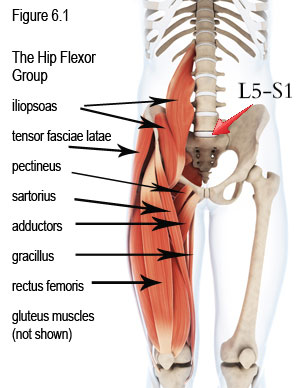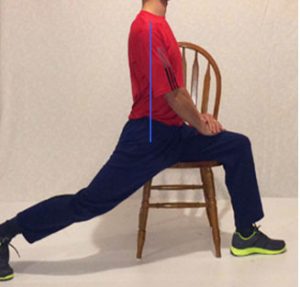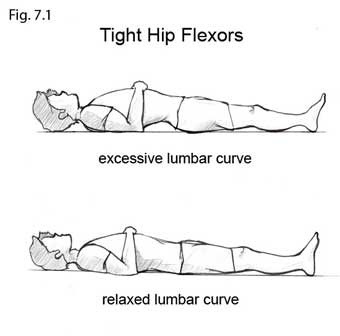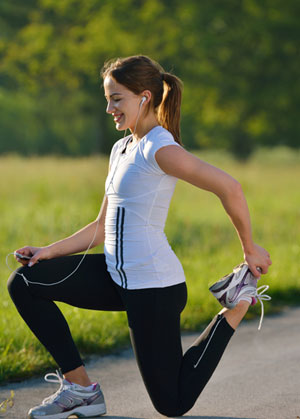Got Back pain? Check Your Tight Hip Flexors
By Sherwin Nicholson | Updated May 1, 2020
For the millions of people suffering from Lower Back Pain (LBP), most of us do not realize that tight hip flexors are also a source of what is hurting us.
It is not very common to have both LBP and healthy, conditioned hip flexors, except in instances of disease or injury. In cases of chronic LBP (which involve muscular imbalance), they are both often responsible for this condition.
It’s affecting everyone now
It is a common problem which affects most people at some time in their life. As you get older and with the every increasing need to sit down more than ever, this situation is affect more of us every day.
The statistics range from 1-2 adults for every 5 when asked if they have experienced pain within the last month with repeated episodes.

This essential group of muscles are generally not suspected as a problem until mobility and injury happen.
Some of these muscles, which include the psoas major, iliacus and tensor fasciae latae are difficult to target physically.
Most of us do not even realize just how important these muscles really are until they begin to weaken and cause mobility issues for us. When they do not function well, they become weaker and tighter from lack of use. This causes adaptive shortening which reduces the mobility of the joints they operate (especially your lumbar spine).
Reduced mobility also leads to reduced use and increased strain on your joints
It also results in overcompensation of other joints and areas which include the lumbar spine. If you lose this mobility, you can seriously affect both your lower back and knees. When patients report issues with lower back symptoms, a limited extension range of motion (ROM) with hip muscle tightness is usually associated.
These patients also present with what is called ‘lower quarter’ and functional limitations. Often when a patient complains of tight hip symptoms experienced with pain, they most likely have lumbar related symptoms as well.
Unfortunately, our typical lifestyles are terrible for your hip flexor health. The average person spends too much time in a sitting position throughout the day. This only adversely affects the health of your muscles and any surrounding joints.
Whether you are seated at work, during your commute or at home, these muscles are in a constant state of contraction, shortening and are exert minimal energy. Circulation to the muscles is also very poor along with issues of piriformis muscle and sciatic nerve irritaion.
If your office chair is hurting you too much, start these 5 At Work tips now.
Over the years, they become weakened and easily fatigued
Your hip flexors can diminish in tone and their overall conditioning is also likely reduced. Even when in a standing position, they will exert little effort and movement necessary to their well-being.
As a result, it becomes progressively easy to neglect them. This is because most of us are not aware of what to do to correct it the problem. Also, because the average sedentary lifestyle encourages you to remain in a seated position with little opportunity for exercise or movement, it become harder to overcome this problem.
Sitting contributes to the shortening and weakening of the hips flexors. In fact, sitting would be the ideal method in which to put them in a shortened position.
When you are sore, your first reaction is to try to adjust your lumbar support, seat cushion or mattress. It may help to adjust your position to alter your comfort level, but it rarely addresses the cause.
These methods provide a short term fix for a long term problem. For example, if you are feeling sore while reading this page, you may feel that by standing or massaging your back, or by simply arching or twisting your body, you will have some needed relief. It is certainly true, but if you find yourself relying on this habit repeatedly, then there is a much deeper issue.
Try this stretch for your tight hip flexors
Part of the solution is not to stand but to lower one leg beside your seat and then to stretch it behind you. This stretches the psoas major, a major culprit for causing you to hurt. This exercise can be found in the Sitting Pain page.
This stretch should be performed often and even when any soreness or tightness is not present. This helps to relieve symptoms of discomfort and will stretch the iliopsoas and rectus femoris muscle.

Whenever you do this, you also readjust your pelvic tilt from one of a posterior tilt, towards anterior to become neutral. This helps you prevent lumbar disc bulge and also alleviates any soreness found among the muscles of your back.
Most of us do not complain of having sore hip flexors unless we have overused them from exercise. Rather, we complain of the other areas of the body that they affect. Some of these regions include the lumbar vertebrae.
If yours have become shortened and weak, you may experience a dull, aching sensation throughout your day and particularly as you are in a standing position.
This is because of the psoas major attaches from the femur to your lumbar vertebrae. (This muscle is illustrated in figure 6.1 as part of the iliopsoas). This allows this muscle to flex the hip joint upon contraction thereby raising your lower legs.
This action is required every day, ranging from kicking a ball to walking upstairs.
When standing, there is a pull on the lumbar vertebrae, resulting in discomfort due to an over-arched lower back. This becomes more evident if you were to lie flat on the floor and observe whether or not your back arched or lifted off of the floor.

This is also true of another key flexor called the rectus femoris (fig. 6.1). A loose, well-stretched psoas major would allow your spine to rest closer or fully with the floor. As a rule, if you can slip your entire hand behind your lumbar spine while lying down, your hip flexors may be too tight. You may likely experience discomfort while performing this test.
Take care of these essential muscles, or else the effort that you put into your relief is lost. It’s tempting to skip working on them but they are a big part of resolving your pain.
Our best attempts to solve LBP become temporary. They require flexibility for proper mobility in which they are both lengthened and strengthened well.
Most of us already know that stretching and strengthening is the key
We can readily go online and find countless images of perfectly healthy individuals demonstrating for us how to perform these movements. We can copy their movements or videos and begin a routine.
Massage and massage therapy is often a very common method in which to help relieve flexor pain. It certainly has its benefits. Pain is effectively reduced, but frequent visits are required.
Some methods to address tightness include techniques which apply different ways in which to stretch. Passive, ballistic and proprioceptive (PNF) stretching are among them. These methods can be very effective if done correctly and routinely.
Some studies indicate that subjects with lumbar or LBP symptoms who performed either passive or active stretching for tight hip flexors improved the range of motion of their hips over a 3-6 week period. Either method was found to be equally beneficial.
It should be noted that passive stretching increases a muscles’ viscoelastic ability. Here, when a muscle is stretched over a constant period, initially it will resist the stretch.
After a short time, it will gradually relax and lengthen. When this is done routinely, the muscles then learn to relax and lengthen in a more efficient manner. This will allow the stretch to facilitate faster and more effectively when performed as a routine.
How you can alleviate the pain now
If you have not yet found relief, this website is geared for you. It encourages a structured, safe, easy and effective method to address your tight flexors. There are many exercises that can be learned throughout this site. For are more comprehensive and effective program, please read the program page. It offers a real alternative to simply copying the movement of models and athletes or other professionals who merely study pain and have yet to struggle and overcome it.
Spend the time to go through the many pages and informative suggestions. Here you can find numerous pages and illustrations available to provide much-needed help. It is worth the investment.

